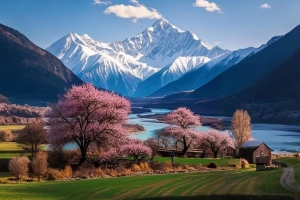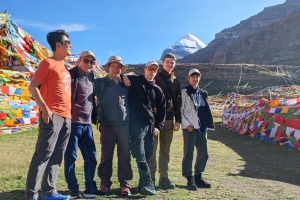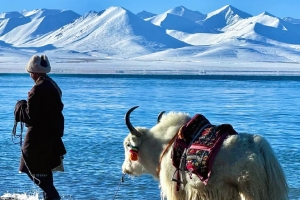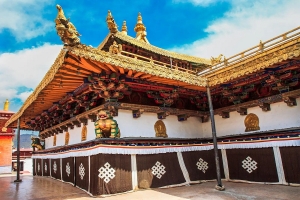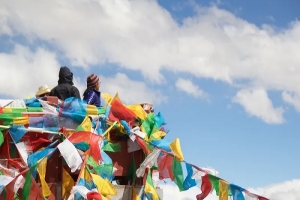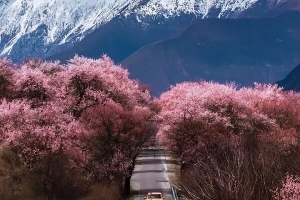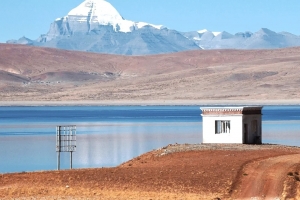Tibet is not merely a destination; it is a realm where history, spirituality, and nature converge. The region’s high-altitude plateau, stunning mountain ranges, and serene lakes create a landscape that seems almost otherworldly. For centuries, Tibet has been a center of Buddhist thought, attracting scholars, pilgrims, and adventurers alike. Its cultural traditions, rituals, and art have evolved over millennia, making it a treasure trove of heritage that the local authorities are determined to safeguard.
While Tibet’s beauty is undeniable, the region’s fragile ecological balance and rich cultural legacy require careful stewardship. The Chinese government, which administers the Tibet Autonomous Region, has put in place stringent travel restrictions as part of a broader strategy to protect Tibet’s natural environment and cultural identity. These measures aim not only to limit the potentially harmful effects of mass tourism but also to preserve the region for future generations. By controlling access through a system of permits and organized tours, the government seeks to balance the demands of tourism with the need for preservation and security.
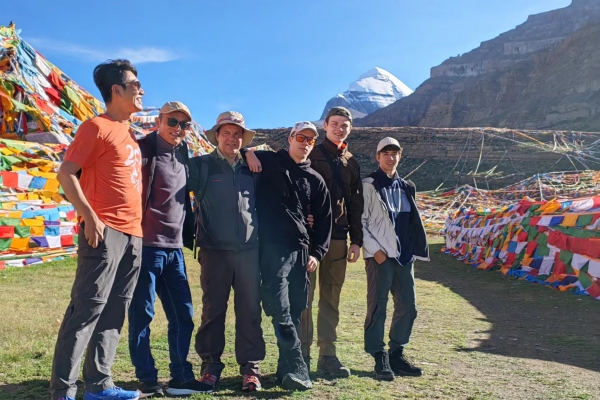
Foreign Tourists in Tibet
Cultural Preservation: Safeguarding a Unique Heritage
Protecting Ethnic Traditions and Relics
One of the primary reasons for travel restrictions in Tibet is the preservation of its unique ethnic traditions. Tibet’s cultural heritage is rich with traditions, festivals, art, and ancient practices that are distinct from those found in other parts of China. The government has a vested interest in ensuring that these traditions are not diluted or lost due to unregulated tourism. By imposing travel restrictions and mandating organized tours, authorities can better manage visitor interactions with local communities, historical sites, and sacred relics.
Controlled Tourism as a Cultural Shield
Unrestricted tourism can sometimes lead to the commercialization of cultural practices and the degradation of historical sites. In Tibet, where many cultural relics are intertwined with religious beliefs and centuries-old customs, such exposure could lead to unintended consequences. The requirement for the Tibet Travel Permit helps ensure that tourists are guided by professionals who understand the local context, thereby minimizing the risk of cultural insensitivity or inadvertent damage. This controlled approach allows for a respectful exchange between visitors and the local population while keeping the integrity of Tibet’s cultural narrative intact.
The Role of Local Authorities in Cultural Preservation
Local authorities in Tibet are deeply involved in the management of tourism. They work closely with tour operators to ensure that itineraries are carefully planned and that tourists have access only to approved sites. This not only protects sacred spaces and cultural relics but also helps maintain the authenticity of Tibetan traditions. In effect, the travel restrictions serve as a cultural shield, preventing over-commercialization and ensuring that visitors experience Tibet in a way that honors its past.
Environmental Conservation: Protecting a Fragile Ecosystem
Tibet’s Unique Ecological Landscape
The Tibetan Plateau, often referred to as the “Roof of the World,” is home to some of the most unique and fragile ecosystems on the planet. High-altitude grasslands, pristine lakes, and diverse flora and fauna define the region. However, these ecosystems are extremely sensitive to external disturbances. The influx of tourists, if left unchecked, could lead to environmental degradation, erosion, and disruption of local wildlife habitats.
Mitigating Environmental Impact Through Regulation
The Chinese government has implemented travel restrictions in Tibet as a means of environmental conservation. By requiring all foreign visitors to join organized tours and obtain the Tibet Travel Permit, authorities can regulate the number of people who access sensitive areas. This regulation is crucial in preventing the overuse of natural resources and ensuring that tourism does not compromise the ecological balance of the region.
Sustainable Tourism Practices
Sustainable tourism is at the heart of the regulatory framework in Tibet. Tour operators are required to adhere to strict guidelines that minimize environmental impact. This includes limits on the number of visitors allowed at any given site, restrictions on the use of certain vehicles, and strict rules about waste disposal. By enforcing these standards, the government aims to create a sustainable tourism model that benefits both the environment and local communities. In essence, these measures ensure that Tibet remains as pristine as possible for future visitors and generations.
Security Concerns and Government Oversight
Maintaining Order in a Sensitive Region
Tibet is not only a region of cultural and natural significance but also one that has been historically sensitive from a political and security standpoint. The Chinese government maintains a strong presence in Tibet, and travel restrictions are partly motivated by the need to ensure stability and security. The requirement for the Tibet Travel Permit is one aspect of a broader strategy to monitor and control the flow of people into this strategically important region.
The Role of Organized Tours in Enhancing Security
For foreign visitors, the mandate to travel with a licensed tour guide is not just a bureaucratic formality—it is a security measure. Organized tours ensure that visitors are constantly under supervision, reducing the risk of unauthorized access to sensitive areas. This controlled approach allows the authorities to quickly address any security issues that might arise and ensures that visitors are protected during their stay. In regions where political tensions or potential unrest could be a concern, such measures are seen as essential for maintaining order and ensuring the safety of both tourists and locals.
Balancing Tourism with National Security
While these restrictions may seem inconvenient to travelers, they are part of a delicate balancing act. The Chinese government is tasked with promoting tourism—a key economic driver—while simultaneously safeguarding national security and regional stability. By imposing controlled access and requiring permits, the authorities are able to keep a close watch on who enters Tibet, thereby mitigating risks associated with independent travel and unsupervised visits. This balance between openness and security is at the core of Tibet’s travel policies.
Understanding the Tibet Travel Permit

Tibet Travel Permit
What is the Tibet Travel Permit?
The Tibet Travel Permit is a special document issued by the Tourism Bureau of the Tibet Autonomous Region. It is mandatory for all non-Chinese passport holders who wish to visit Tibet. This permit acts as an official authorization, allowing travelers to board flights, trains, or other forms of transportation to Tibet. The permit also outlines the approved itinerary, which must be adhered to during the stay.
Who Needs the Permit?
The permit requirement is not limited to foreign tourists alone. It applies to several groups:
- Foreign Nationals: Visitors holding passports issued by countries other than China must obtain the permit.
- Taiwanese Tourists: Even though Taiwan has a unique status, its residents are subject to the same requirements as other foreign visitors.
- Overseas Chinese with Foreign Passports: Chinese nationals holding passports from other countries are also required to secure the permit.
- Special Categories: Journalists, diplomats, and government officials face different protocols. Instead of the standard tourism permit, they must obtain approval from the Foreign Affairs Bureau, reflecting the heightened security and political sensitivities of their visits.
The Application Process
Applying for the Tibet Travel Permit is an essential step in the planning process for any visitor. Typically, the application must be handled by a registered travel agency in China. This agency submits the necessary paperwork to the Tourism Bureau, ensuring that the application complies with all current regulations. The process involves verifying the traveler’s identity, reviewing the proposed itinerary, and confirming that all travel arrangements meet government standards.
Restrictions and Limitations
Even with a valid permit, visitors are not free to roam Tibet as they wish. The permit specifies the exact areas and sites that are accessible during the trip. Certain regions, deemed sensitive or environmentally vulnerable, remain off-limits to tourists. These restrictions include areas such as:
- The Yarlung Tsangpo Grand Canyon: Known for its dramatic landscapes but considered too sensitive for unsupervised tourist access.
- Lhamo La Tso: A sacred lake with significant spiritual importance.
- Yadong County and Chamdo: Regions with heightened security concerns.
- Sites of Sky Burials: Areas where traditional Tibetan sky burial ceremonies take place are restricted to maintain respect for local customs.
By delineating which areas are open for tourism and which are not, the permit system helps preserve the integrity of Tibet’s natural and cultural treasures.
Travel Options for Foreigners

Participate in Organized Tours
For foreign visitors, the only legal way to explore Tibet is through an organized tour arranged by a licensed travel agency. This requirement is in place for several reasons:
- Ensuring Compliance: Guided tours help ensure that travelers adhere to the approved itinerary and do not inadvertently enter restricted zones.
- Safety Measures: A knowledgeable tour guide can navigate the logistical and regulatory challenges of traveling in a high-altitude, politically sensitive region.
- Streamlining the Permit Process: Tour agencies are well-versed in the permit application process, making it easier for tourists to obtain the necessary documentation.
Modes of Transportation
Once the permit and tour arrangements are in place, travelers can reach Tibet via several transportation methods:
- By Air: Multiple flights connect major Chinese cities like Beijing, Shanghai, Chengdu, and Xi’an with Lhasa, the capital of Tibet. Air travel is the most common and convenient option for reaching the region.
- By Train: Trains from cities such as Beijing and Chengdu offer a scenic journey across the varied landscapes of China, culminating in the breathtaking vistas of the Tibetan Plateau.
- By Road: For those who prefer the adventure of a road trip, several major routes lead to Tibet. These include the Qinghai-Tibet, Xinjiang-Tibet, Yunnan-Tibet, and Sichuan-Tibet highways. Even self-drive tours or bicycle tours are available, though they require the constant accompaniment of a local guide and support vehicle to comply with regulations.
Special Routes: Entry via Nepal
An interesting alternative for foreign tourists is entry into Tibet via Nepal. Nepal is unique in that it maintains an international flight route to Tibet, specifically connecting Kathmandu with Lhasa during the high season (typically May to October). Additionally, overland travel via the Gyirong and Zhangmu border crossings is another option. However, travelers entering Tibet from Nepal must secure a special Chinese Group Visa, which is issued by the Chinese Embassy in Kathmandu. This alternative route demonstrates the flexibility within the broader framework of travel regulations while still maintaining strict oversight.
Special Cases: Journalists, Diplomats, and Government Officials
Different Protocols for Different Roles
While tourism is a major focus of Tibet’s travel policies, not all visitors are classified as regular tourists. Foreign journalists, diplomats, and government officials have different protocols when it comes to visiting Tibet. These groups are subject to a more rigorous approval process managed by the Foreign Affairs Bureau. The heightened scrutiny reflects both security concerns and the sensitive nature of the information they might report or the diplomatic activities they might engage in.
The Importance of Pre-Approval
For these special categories, pre-approval is not just a bureaucratic requirement—it is a vital step in ensuring that their visits do not inadvertently affect regional stability. The process usually involves a detailed review of the intended itinerary, background checks, and coordination with multiple government agencies. Although this process may seem cumbersome, it is designed to provide an additional layer of oversight and ensure that all interactions in Tibet are conducted in a controlled and secure manner.
The Impact of Restrictions on the Tourist Experience
Benefits of a Managed Tourism Model
At first glance, strict travel restrictions might appear to limit the freedom of travelers. However, there are several benefits to this managed tourism model:
- Enhanced Safety: The presence of licensed tour guides and constant monitoring ensures that visitors have a safe experience, even in remote or challenging environments.
- Cultural Sensitivity: Guided tours help bridge cultural gaps, ensuring that tourists interact with local traditions respectfully and meaningfully.
- Environmental Protection: By regulating access to sensitive areas, the permit system helps preserve the pristine conditions of Tibet’s natural habitats.
Despite these benefits, there are also challenges associated with the current travel regulations:
- Limited Flexibility: Independent travel is not allowed for foreign visitors, which can be frustrating for those who prefer exploring at their own pace.
- Cost Considerations: Organized tours can be more expensive than self-planned itineraries, potentially limiting access for budget-conscious travelers.
- Restricted Itineraries: The requirement to adhere to a pre-approved itinerary means that tourists might miss out on experiencing the full breadth of Tibet’s offerings, particularly if they have niche interests or wish to explore off the beaten track.
Balancing Tourism and Regulation
The delicate balance between preserving Tibet’s cultural and environmental heritage while promoting tourism remains a constant challenge for authorities. On one hand, uncontrolled tourism could lead to irreversible changes and degradation of both natural and cultural sites. On the other, tourism is an important economic driver that supports local communities. The current regulatory framework, while sometimes seen as restrictive, aims to strike a balance that allows for sustainable tourism while protecting Tibet’s invaluable legacy.
Practical Considerations for Planning a Trip to Tibet
Preparing for the Permit Process
If you are considering a trip to Tibet, thorough preparation is essential:
- Select a Reputable Travel Agency: As the only legal way to travel in Tibet is via an organized tour, choose a travel agency with a strong track record and deep knowledge of local regulations.
- Understand the Itinerary: Familiarize yourself with the approved itinerary on your Tibet Travel Permit. Know which areas are accessible and which are off-limits.
- Medical Considerations: Given the high altitude and challenging conditions, it is advisable for older travelers or those with pre-existing health conditions to consult a doctor before embarking on the journey.
What to Expect During Your Trip
Traveling in Tibet is a unique experience that comes with its own set of expectations:
- Cultural Interactions: Expect guided visits to historical sites, monasteries, and local communities where cultural exchanges are carefully moderated by your tour guide.
- Restricted Areas: Understand that some parts of Tibet will remain off-limits. While this might seem limiting, it is a measure designed to protect both the environment and cultural heritage.
- Group Dynamics: The requirement to travel in groups means that your experience will be shared with other tourists. This can enhance your journey by providing opportunities for shared learning and camaraderie among travelers from different backgrounds.
Tips for a Smooth Journey
To make the most of your trip while adhering to the guidelines:
- Plan Ahead: Start the planning process well in advance to account for permit applications and travel agency arrangements.
- Stay Informed: Keep abreast of any changes in regulations or travel advisories issued by local authorities. Policies can evolve, and staying informed will help avoid any last-minute surprises.
- Embrace the Guided Experience: While independent exploration might be limited, use the opportunity to learn from local guides who can offer insights into Tibetan history, religion, and culture that you might not encounter on your own.
Frequently Asked Questions about Tibet Travel Restrictions
Is Tibet Open to Tourists?
Yes, Tibet is open to tourists, and foreign visitors are welcome. Since the easing of travel restrictions following the pandemic, tourism has gradually rebounded. However, the requirement for a Tibet Travel Permit remains strictly enforced.
Can Foreigners Travel to Tibet Without a Tour?
No, independent travel is not permitted for foreign tourists. The law mandates that all foreign visitors must join an organized tour and obtain a Tibet Travel Permit. This requirement is designed to manage both cultural and environmental impacts and to ensure the safety of all visitors.
Why Do Foreigners Need a Tibet Travel Permit?
The permit is essential for several reasons:
- Cultural Preservation: To protect Tibet’s unique traditions and historical sites.
- Environmental Conservation: To safeguard fragile ecosystems from over-tourism.
- Security Measures: To ensure that travel is monitored and controlled, reducing risks associated with unsupervised visits.
What Are the Special Requirements for Journalists and Diplomats?
Journalists, diplomats, and government officials must follow a different process. They are required to secure special approval from the Foreign Affairs Bureau, reflecting the sensitive nature of their visits. This additional layer of approval helps maintain security and ensures that their presence does not inadvertently impact regional stability.
Are There Any Areas in Tibet That Remain Off-Limits?
Yes, certain regions and attractions in Tibet are restricted. These include areas like the Yarlung Tsangpo Grand Canyon, Lhamo La Tso, and certain border regions. The permit clearly outlines the accessible areas, and travelers must adhere to the approved itinerary.
Travel to Tibet Through A Regular Travel Agency
In fact, as long as you travel to Tibet through a regular travel agency, Tibet’s travel restrictions have no substantial impact on foreign tourists. In planning your trip, remember that the process—from applying for the Tibet Travel Permit to choosing a reputable tour operator—is designed to ensure your safety and the protection of this irreplaceable heritage.

